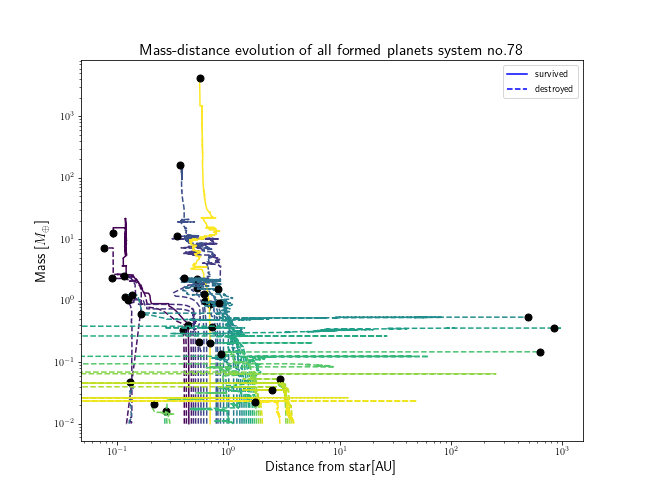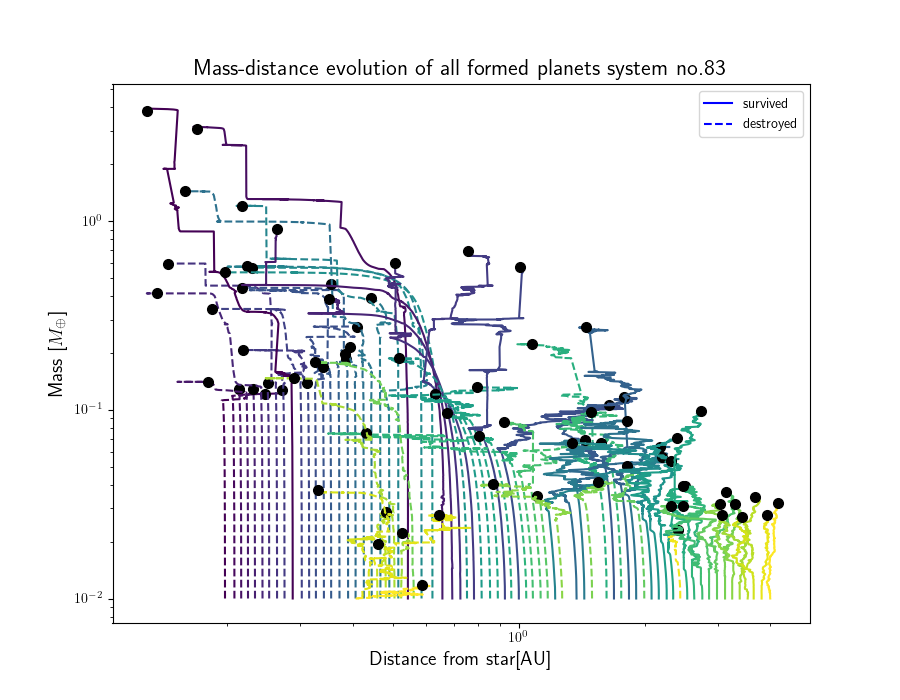The formation of giant planets in disks with consistent planetesimal and embryo formation
- Max-Planck Institute for Astronomy, Planet and Star Formation, Heidelberg, Germany (bauernfeind@mpia.de)
Planetary population synthesis is a tool to investigate planet formation by using a simplified global end-to-end planet formation model to create artificial planet populations. This makes it possible to statistically compare model predictions with observations, and to better understand the physical mechanisms of planet formation and their interactions. This project uses the Bern population synthesis model for planetary formation but pushes its boundaries to the earlier stage of planetesimal and embryo formation.
The model combines the two-population model (Birnstiel et al. 2012) for the solid evolution with a pebble-flux regulated planetesimal formation (Lenz et al. 2019), and then grows planetary embryos from the planetesimals (see Voelkel et al. 2021, paper II). This eliminates the strong assumption of where to place initial planetary embryos in planet formation models.
Further, we use a modern disk model including an MRI-like alpha transition, weak disk winds (Weder et al. 2023), and thermal torques for planetary migration. Parameters like the planetesimal size and planetesimal fragmentation velocity were varied, and the influence of migration and pebble accretion on the planet evolution were also studied.
We find a significant under-representation of giant planets, especially cold giants, in all our populations. Only by excluding orbital migration, a sufficient number of cold giant planets could form. Reducing the planetesimal fragmentation velocity or increasing the efficiency of pebble-to-planetesimal conversion all strongly reduce the fraction of giants. These results highlight the added complexity of including a self-consistent planetesimal and embryo formation in global planet formation models.


Figures: Mass-distance evolution of the formed planets in two systems of the nominal population. Violet tracks mean the planet formed early, yellow tracks that it formed late. Horizontal lines mean the planet was ejected from the system. Dotted lines mean the planet was destroyed (ejected, accreted by star, collided with another planet)
References:
Emsenhuber, A., Mordasini, C., Burn, R., Alibert, Y., et al. 2021, A&A 656, A69
Lenz, C.T., Klahr, H. & Birnstiel, L. 2019, ApJ 874 A36
Völkel, O., Deienno, R., Kretke, K., & Klahr, H. 2021, A&A 645, A132
Weder, J., Mordasini, C., Emsenhuber, A. 2023, A&A 674, A165
How to cite: Bauernfeind, A., Burn, R., Voelkel, O., and Klahr, H.: The formation of giant planets in disks with consistent planetesimal and embryo formation, Europlanet Science Congress 2024, Berlin, Germany, 8–13 Sep 2024, EPSC2024-1141, https://doi.org/10.5194/epsc2024-1141, 2024.